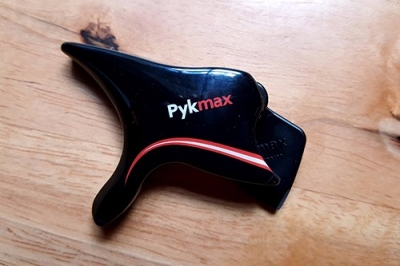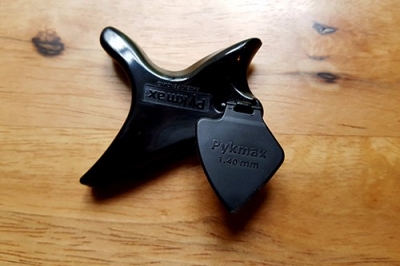Welcome to our forum. A Message To Our New and Prospective Members . Check out our Forum Rules. Lets keep this forum an enjoyable place to visit.
Currently working on errors from the latest (SimplePress) forum update. Many issues have been resoled and others are being worked on. Thank you for your patience.
 Topic RSS
Topic RSS



 (0 votes)
(0 votes) Member
 Offline
OfflineOkay, so I just got a mandolin. Since it has the same fingering pattern as the violin (the double strings are GG DD AA EE), I'm playing through my regular tune-books, and for now--sticking to the keys of G and D, which most fiddle music is in anyway.
I've only had this mandolin for three days, and know that there are chords that I can learn if I got a book or looked online, but I like playing the melody notes for now.
I'm curious how other forum members use their mandolins (melody vs. chords), and how people learned the mandolin-specific things (what books or YouTube videos for example).
One thing I noticed immediately about the mandolin is how quiet it is compared to the violin, and no high-pitched E string (I mean it does have the E, actually two of them, but the tonal quality is very different from violin).
Regulars
 Offline
Offline

I toyed with the idea of getting a mandolin (I like the sound and I've found it MUCH easier to pick out tunes by ear on an instrument tuned in fifths than the weird pattern used with guitars). But I found the tension was pretty high and it uses steel strings, which means a lot of time and pain to build up the necessary calluses (I switched to nylon-string guitars quite a few years back for that same reason.) So I declined for now.
Since a violin (or any bowed instrument) is being "plucked" lots of times per second, I suspect that shrill sound that comes from cheap strings and/or violins must mostly happen in that first fraction of a second after it's plucked. In a mandolin, that's gone before it's really audible, whereas in a violin it's getting recreated over and over.
Makes sense, when I think about it. Shrill sounds are high pitches, generally, and the higher overtones happen when the string has the most energy. As its energy decreases, you get fewer (and less high-pitched) overtones, as well as a decrease in volume of the main tone. (More accurately, the strength of the overtones decreases below audibility.) That actually suggests that the better strings/violins (the ones that don't sound shrill even on the high notes) are suppressing those higher harmonics.
Member
 Offline
OfflineThanks @charles
I'm now one week into learning mandolin and enjoy having something that complements violin playing. I've been playing my regular violin tunes since it has the same GDAE tuning, but really need to start learning the mandolin-specific techniques (like alternate picking).
In searching for a free online book, I just happened to find this:
https://archive.org/details/bi.....olin01bick
You can download this Bickford Mandolin Method as a PDF file.
I hope to get started with the book this week, and wanted to share this resource with others that may be interested in learning the mandolin.
By the way, I got a Rover RM-35s mandolin (inexpensive solid-top model made by the same company that makes the more expensive Kentucky mandolin brand), with Golden Gate MP-12 picks, Planet Waves strap, and Musician's Gear Hardshell A-style case. I didn't do much prior research, but it seems like a nice instrument.
I've heard good things about the Rover line. Enjoy learning and playing. Try to stay away from fixing and "making it better",,,that leads to the dark side. Mandolin cafe is a good resource. I found it necessary to always have some spare sets of strings on hand and I went to Just strings to get spare E strings.
Advanced member
 Offline
OfflineI have the old, tired but true answer of it depends on what type of music you wanna play.
Now that you can add more chords to your playing, you can play rhythm in any folk, country, rock, or pop song you like. The mandolin has made its way into popular music and is prominent in REM's "Losing My Religion" and the repeating riff in Rod Stewart's "Maggie May". Then there's plenty of Bill Monroe-inspired Bluegrass.
Personally, I've practiced both rhythm and melody. If you think the mandolin is too quiet, try hammering those chords, especially with some chops. Try experimenting with different pick thicknesses. I found my mando/string combo got the most tone out of 1.14mm Dunlop Tortex picks but most players prefer thick picks. Get the tremolo down early, it opens a lot of expressiveness.
Having a cheap mandolin, you probably have a very high action. This can be compensated for somewhat with the adjusting screws in the bridge. Cheap bridges however are plagued with the holes the screws are in not being bored out fully or evenly so be aware. The nuts are also very high but that's a less user-friendly adjustment.
You can also correct for intonation(as it's probably a little off) by adjusting bridge placement fore and aft. Unfortunately the notches in the F holes don't always make an accurate guide and the bridge may even need to be skewed to get better intonation across the strings.
I say this not to criticize your choice of mandolin but that I also have a cheap one and wish I didn't have to learn these tricks the hard way.
Regulars
 Offline
Offline




Strangely enough I just got a mandolin last week to mess around with, Musicans friend had a rogue mandolin for 50.00 every thing I read about it said it would need a set up, when it arrived I found the nut and bridge along with intonation were good had the raise the G string side of the bridge a half a turn. It does have a little fret noise when playing high up the G string but for the money I am amazed it plays and sounds as good as it does. 30 years ago I had a tater bug mandolin that I messed around with that had a super skinny neck that I never liked. What surprised me is my hand remember the shapes of the G,C,D,A,Em cords, now my picking skills have a lot to be desired, but that will come in time. Have fun with the mandolin.
Mark
Master the Frog and you have mastered the bow.
Albert Sammons
At Mandolin Cafe there is a traveling sampler pack. You sign up and when its your turn a pack of approximately 50 picks are sent to you to try and then you send it on to the next person on the list. Its a great way to learn what you like. ((This is something FM might think about with chin rests))
There is a product called a tone gard that keeps the back away from you which can add 10% more volume and also a arm rest which keeps your arm off the front table. Both of these products can help your sound. I made my own using viola chin rest clamps. A cheap china gig bag ($10) is all I need.
I went to jam sessions for a while until I learned that I am not smart enough yet to join in with others (I was playing in A, they were playing in A minor).
Member
 Offline
OfflineI thought I would revive this thread after four months of no posts, to update on my experiences.
I had decided to try mandolin as an alternative or complement to violin, because my main violin issues are: the high pitches can hurt my ears (and ear plugs and various mutes haven't been a good solution for me) and the ergonomics of holding the instrument are difficult for me.
Mandolin was easier on the ears, but still too high pitched for me. The ergonomic challenges of mandolin were different, but not really better in that even after trying light strings, my fingers still hurt (even after getting calluses).
I switched from mandolin to the Yamaha GL-1 guitalele, which is basically a tenor ukulele with two extra strings, which is tuned like a guitar with a capo at the fifth fret. After using the guitalele for a few months, everything with that instrument is going extremely well. The nylon classical guitar strings are easy on the left hand, and I use a felt pick (instead of fingers) to protect my right hand from pain. I'm playing single line melodies (my same violin music) rather than chords.
I still have my violin, but really do see my future in staying with the guitalele, and I'd like to try some other instruments too. I just bought an alto recorder and a melodica, and plan to start learning those soon.
Overall, violin for me was great for learning music theory, and for getting exposure to new types of music. I was drawn to Irish tunes at first, but later discovered that I like Renaissance dance music (especially from Michael Praetorius' 1612 collection called Terpsichore). I can play all my violin music on the guitalele (except the lowest note is A below the staff, instead of G below the staff).
My main point of posting this, is that the guitalele is a similar size to mandolin, and may be a more appropriate instrument for some folks, so I wanted to share that. I also wanted to share that it was a very easy transition for me from violin, and much easier to get a nice sound out of the instrument (without the intricacies of bowing), and intonation was easy on all keys due to the frets.
For now, my violin sits in its case. If I return to it at some point, I believe that lessons would be beneficial. While I got the hang of it through self-teaching, I always would cringe after watching an iPhone video of myself playing. Oh well...the raw truth.
The violin is a lovely instrument for so many people to learn, and I still love to listen to violin music from others. Best wishes to everyone.
Regulars
 Offline
Offline

Next time you get the urge to do something violin-like (or just play an intstrument tuned in fifths, which I personally find MUCH easier to pick out songs on than guitars), try restringing your violin as a viola. Each string will be a 5th lower, which should help quite a bit with the too-shrill problem. (You probably will need to get special strings designed for that. Just loosening the regular strings that much will leave them too Floose to play decently. (You could also just get the C string and move the other three up one.) If you find you like it, you might want to work on (or have somebody work on) the nut and the bridge, to better accomodate the thicker strings.
And, of course, just getting a viola would work, too. 🙂
1 Guest(s)


 Log In
Log In Register
Register
















